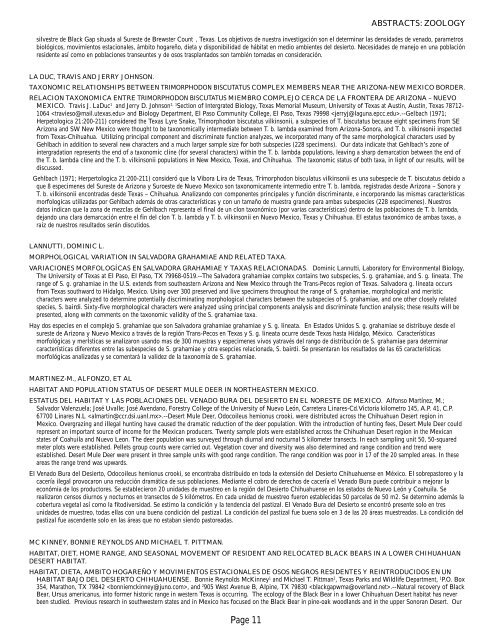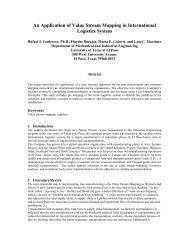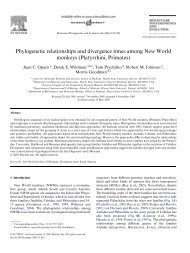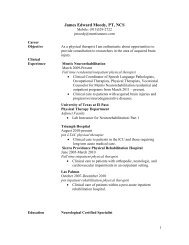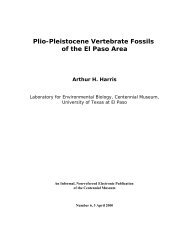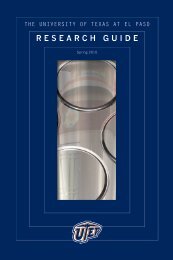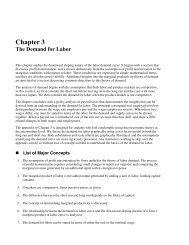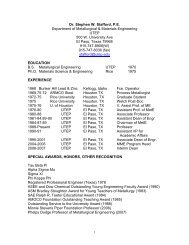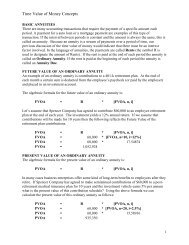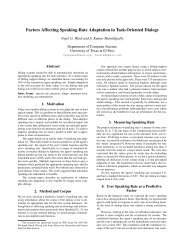Sym - Abstracts - University of Texas at El Paso
Sym - Abstracts - University of Texas at El Paso
Sym - Abstracts - University of Texas at El Paso
You also want an ePaper? Increase the reach of your titles
YUMPU automatically turns print PDFs into web optimized ePapers that Google loves.
ABSTRACTS: ZOOLOGY<br />
silvestre de Black Gap situada al Sureste de Brewster Count , <strong>Texas</strong>. Los objetivos de nuestra investigación son el determinar las densidades de venado, parametros<br />
biológicos, movimientos estacionales, ámbito hogareño, dieta y disponibilidad de hábit<strong>at</strong> en medio ambientes del desierto. Necesidades de manejo en una población<br />
residente así como en poblaciones transeuntes y de osos trasplantados son también tomadas en consideración.<br />
LA DUC, TRAVIS AND JERRY JOHNSON.<br />
TAXONOMIC RELATIONSHIPS BETWEEN TRIMORPHODON BISCUTATUS COMPLEX MEMBERS NEAR THE ARIZONA-NEW MEXICO BORDER.<br />
RELACION TAXONOMICA ENTRE TRIMORPHODON BISCUTATUS MIEMBRO COMPLEJO CERCA DE LA FRONTERA DE ARIZONA – NUEVO<br />
MEXICO. Travis J. LaDuc 1 and Jerry D. Johnson 2, 1 Section <strong>of</strong> Intergr<strong>at</strong>ed Biology, <strong>Texas</strong> Memorial Museum, <strong>University</strong> <strong>of</strong> <strong>Texas</strong> <strong>at</strong> Austin, Austin, <strong>Texas</strong> 78712-<br />
1064 and Biology Department, <strong>El</strong> <strong>Paso</strong> Community College, <strong>El</strong> <strong>Paso</strong>, <strong>Texas</strong> 79998 .--Gelbach (1971;<br />
Herpetologica 21:200-211) considered the <strong>Texas</strong> Lyre Snake, Trimorphodon biscut<strong>at</strong>us vilkinsonii, a subspecies <strong>of</strong> T. biscut<strong>at</strong>us because eight specimens from SE<br />
Arizona and SW New Mexico were thought to be taxonomically intermedi<strong>at</strong>e between T. b. lambda examined from Arizona-Sonora, and T. b. vilkinsonii inspected<br />
from <strong>Texas</strong>-Chihuahua. Utilizing principal component and discrimin<strong>at</strong>e function analyzes, we incorpor<strong>at</strong>ed many <strong>of</strong> the same morphological characters used by<br />
Gehlbach in addition to several new characters and a much larger sample size for both subspecies (228 specimens). Our d<strong>at</strong>a indic<strong>at</strong>e th<strong>at</strong> Gehlbach’s zone <strong>of</strong><br />
intergrad<strong>at</strong>ion represents the end <strong>of</strong> a taxonomic cline (for several characters) within the T. b. lambda popul<strong>at</strong>ions, leaving a sharp demarc<strong>at</strong>ion between the end <strong>of</strong><br />
the T. b. lambda cline and the T. b. vilkinsonii popul<strong>at</strong>ions in New Mexico, <strong>Texas</strong>, and Chihuahua. The taxonomic st<strong>at</strong>us <strong>of</strong> both taxa, in light <strong>of</strong> our results, will be<br />
discussed.<br />
Gehlbach (1971; Herpertologica 21:200-211) consideró que la Vibora Lira de <strong>Texas</strong>, Trimorphodon biscul<strong>at</strong>us vilkinsonii es una subespecie de T. biscut<strong>at</strong>us debido a<br />
que 8 especimenes del Sureste de Arizona y Suroeste de Nuevo Mexico son taxonomicamente intermedio entre T. b. lambda, registradas desde Arizona – Sonora y<br />
T. b. vilkinsonii encontradas desde <strong>Texas</strong> – Chihuahua. Analizando con componentes principales y función discriminante, e incorporando las mismas características<br />
morfologicas utilizadas por Gehlbach además de otras características y con un tamaño de muestra grande para ambas subespecies (228 especimenes). Nuestros<br />
d<strong>at</strong>os indican que la zona de mezclas de Gehlbach representa el final de un clon taxonómico (por varias características) dentro de las poblaciones de T. b. lambda,<br />
dejando una clara demarcación entre el fin del clon T. b. lambda y T. b. vilkinsonii en Nuevo Mexico, <strong>Texas</strong> y Chihuahua. <strong>El</strong> est<strong>at</strong>us taxonómico de ambas taxas, a<br />
raiz de nuestros resultados serán discutidos.<br />
LANNUTTI, DOMINIC L.<br />
MORPHOLOGICAL VARIATION IN SALVADORA GRAHAMIAE AND RELATED TAXA.<br />
VARIACIONES MORFOLOGÍCAS EN SALVADORA GRAHAMIAE Y TAXAS RELACIONADAS. Dominic Lannutti, Labor<strong>at</strong>ory for Environmental Biology,<br />
The <strong>University</strong> <strong>of</strong> <strong>Texas</strong> <strong>at</strong> <strong>El</strong> <strong>Paso</strong>, <strong>El</strong> <strong>Paso</strong>, TX 79968-0519.--The Salvadora grahamiae complex contains two subspecies, S. g. grahamiae, and S. g. line<strong>at</strong>a. The<br />
range <strong>of</strong> S. g. grahamiae in the U.S. extends from southeastern Arizona and New Mexico through the Trans-Pecos region <strong>of</strong> <strong>Texas</strong>. Salvadora g. line<strong>at</strong>a occurs<br />
from <strong>Texas</strong> southward to Hidalgo, Mexico. Using over 300 preserved and live specimens throughout the range <strong>of</strong> S. grahamiae, morphological and meristic<br />
characters were analyzed to determine potentially discrimin<strong>at</strong>ing morphological characters between the subspecies <strong>of</strong> S. grahamiae, and one other closely rel<strong>at</strong>ed<br />
species, S. bairdi. Sixty-five morphological characters were analyzed using principal components analysis and discrimin<strong>at</strong>e function analysis; these results will be<br />
presented, along with comments on the taxonomic validity <strong>of</strong> the S. grahamiae taxa.<br />
Hay dos especies en el complejo S. grahamiae que son Salvadora grahamiae grahamiae y S. g. line<strong>at</strong>a. En Estados Unidos S. g. grahamiae se distribuye desde el<br />
sureste de Arizona y Nuevo Mexico a través de la región Trans-Pecos en <strong>Texas</strong> y S. g. line<strong>at</strong>a ocurre desde <strong>Texas</strong> hasta Hidalgo, México. Características<br />
morfológicas y merÍsticas se analizaron usando mas de 300 muestras y especimenes vivos y<strong>at</strong>ravés del rango de distribución de S. grahamiae para determinar<br />
características diferentes entre las subespecies de S. grahamiae y otra esepcies relacionada, S. bairdi. Se presentaran los resultados de las 65 características<br />
morfológicas analizadas y se comentará la validez de la taxonomía de S. grahamiae.<br />
MARTINEZ-M., ALFONZO, ET AL<br />
HABITAT AND POPULATION STATUS OF DESERT MULE DEER IN NORTHEASTERN MEXICO.<br />
ESTATUS DEL HABITAT Y LAS POBLACIONES DEL VENADO BURA DEL DESIERTO EN EL NORESTE DE MEXICO. Alfonso Martínez, M.;<br />
Salvador Valenzuela; José Uvalle; José Avendano, Forestry College <strong>of</strong> the <strong>University</strong> <strong>of</strong> Nuevo León, Carretera Linares-Cd.Victoria kilometro 145, A.P. 41, C.P.<br />
67700 Linares N.L .--Desert Mule Deer, Odocoileus hemionus crooki, were distributed across the Chihuahuan Desert region in<br />
Mexico. Overgrazing and illegal hunting have caused the dram<strong>at</strong>ic reduction <strong>of</strong> the deer popul<strong>at</strong>ion. With the introduction <strong>of</strong> hunting fees, Desert Mule Deer could<br />
represent an important source <strong>of</strong> income for the Mexican producers. Twenty sample plots were established across the Chihuahuan Desert region in the Mexican<br />
st<strong>at</strong>es <strong>of</strong> Coahuila and Nuevo Leon. The deer popul<strong>at</strong>ion was surveyed through diurnal and nocturnal 5 kilometer transects. In each sampling unit 50, 50-squared<br />
meter plots were established. Pellets group counts were carried out. Veget<strong>at</strong>ion cover and diversity was also determined and range condition and trend were<br />
established. Desert Mule Deer were present in three sample units with good range condition. The range condition was poor in 17 <strong>of</strong> the 20 sampled areas. In these<br />
areas the range trend was upwards.<br />
<strong>El</strong> Venado Bura del Desierto, Odocoileus hemionus crooki, se encontraba distribuido en toda la extensión del Desierto Chihuahuense en México. <strong>El</strong> sobrepastoreo y la<br />
cacería ilegal provocaron una reducción dramática de sus poblaciones. Mediante el cobro de derechos de cacería el Venado Bura puede contribuir a mejorar la<br />
económia de los productores. Se establecieron 20 unidades de muestreo en la región del Desierto Chihuahuense en los estados de Nuevo León y Coahuila. Se<br />
realizaron censos diurnos y nocturnos en transectos de 5 kilómetros. En cada unidad de muestreo fueron establecidas 50 parcelas de 50 m2. Se determino además la<br />
cobertura vegetal así como la fitodiversidad. Se estimo la condición y la tendencia del pastizal. <strong>El</strong> Venado Bura del Desierto se encontró presente solo en tres<br />
unidades de muestreo, todas ellas con una buena condición del pastizal. La condición del pastizal fue buena solo en 3 de las 20 áreas muestreadas. La condición del<br />
pastizal fue ascendente solo en las áreas que no estaban siendo pastoreadas.<br />
MC KINNEY, BONNIE REYNOLDS AND MICHAEL T. PITTMAN.<br />
HABITAT, DIET, HOME RANGE, AND SEASONAL MOVEMENT OF RESIDENT AND RELOCATED BLACK BEARS IN A LOWER CHIHUAHUAN<br />
DESERT HABITAT.<br />
HABITAT, DIETA, AMBITO HOGAREÑO Y MOVIMIENTOS ESTACIONALES DE OSOS NEGROS RESIDENTES Y REINTRODUCIDOS EN UN<br />
HABITAT BAJO DEL DESIERTO CHIHUAHUENSE. Bonnie Reynolds McKinney 1 and Michael T. Pittman 2 , <strong>Texas</strong> Parks and Wildlife Department, 1 P.O. Box<br />
354, Mar<strong>at</strong>hon, TX 79842 , and 2 905 West Avenue B, Alpine, TX 79830 .--N<strong>at</strong>ural recovery <strong>of</strong> Black<br />
Bear, Ursus americanus, into former historic range in western <strong>Texas</strong> is occurring. The ecology <strong>of</strong> the Black Bear in a lower Chihuahuan Desert habit<strong>at</strong> has never<br />
been studied. Previous research in southwestern st<strong>at</strong>es and in Mexico has focused on the Black Bear in pine-oak woodlands and in the upper Sonoran Desert. Our<br />
Page 11


